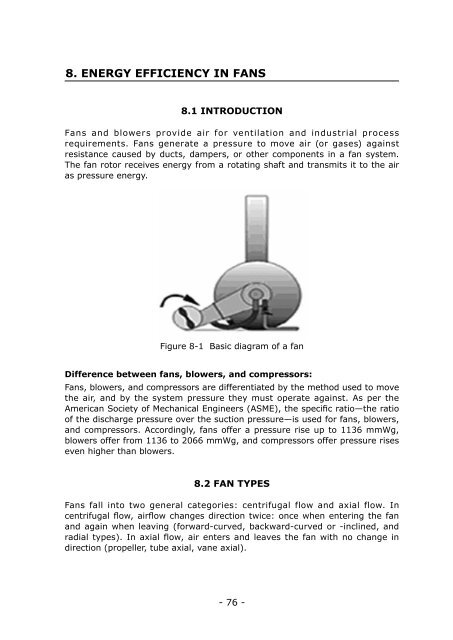Training Manual on Energy Efficiency - APO Asian Productivity ...
Training Manual on Energy Efficiency - APO Asian Productivity ...
Training Manual on Energy Efficiency - APO Asian Productivity ...
You also want an ePaper? Increase the reach of your titles
YUMPU automatically turns print PDFs into web optimized ePapers that Google loves.
8. ENERGY EFFICIENCY IN FANS<br />
8.1 INTRODUCTION<br />
Fans and blowers provide air for ventilati<strong>on</strong> and industrial process<br />
requirements. Fans generate a pressure to move air (or gases) against<br />
resistance caused by ducts, dampers, or other comp<strong>on</strong>ents in a fan system.<br />
The fan rotor receives energy from a rotating shaft and transmits it to the air<br />
as pressure energy.<br />
Figure 8-1 Basic diagram of a fan<br />
Difference between fans, blowers, and compressors:<br />
Fans, blowers, and compressors are differentiated by the method used to move<br />
the air, and by the system pressure they must operate against. As per the<br />
American Society of Mechanical Engineers (ASME), the specific ratio—the ratio<br />
of the discharge pressure over the sucti<strong>on</strong> pressure—is used for fans, blowers,<br />
and compressors. Accordingly, fans offer a pressure rise up to 1136 mmWg,<br />
blowers offer from 1136 to 2066 mmWg, and compressors offer pressure rises<br />
even higher than blowers.<br />
8.2 FAN TYPES<br />
Fans fall into two general categories: centrifugal flow and axial flow. In<br />
centrifugal flow, airflow changes directi<strong>on</strong> twice: <strong>on</strong>ce when entering the fan<br />
and again when leaving (forward-curved, backward-curved or -inclined, and<br />
radial types). In axial flow, air enters and leaves the fan with no change in<br />
directi<strong>on</strong> (propeller, tube axial, vane axial).<br />
- 76 -
















